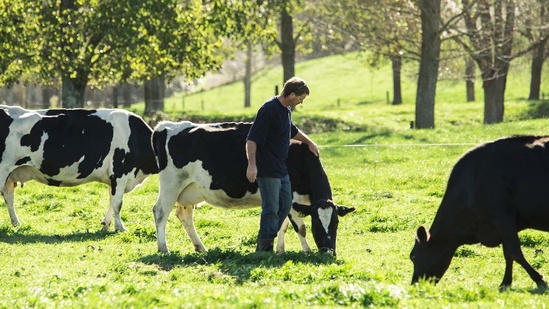The journey of milk
Have you ever wondered how Anchor milk gets from beautiful New Zealand farms to you? The journey is not as simple as you may think. Our nutrient-packed milk goes through quite a process, and passes through the careful hands of our farmers, tanker drivers and factory workers before it reaches shelves in your local supermarket.
Our products end up all around the world, but they all start at the same place – and that place is on the farm. New Zealand’s lush, green pasture sets the scene for our promise of cared-for cows. From the moment our cows are born, they live and eat on the pasture – as nature intended. We never feed our cows any junk food, they eat green grass from the soil and, if needed in the winter months, dried grass silage with no nasty bits – it’s all natural and that’s how we get our products tasting great, every time.
We know our customers appreciate and look for the highest quality products. We also know that our farmers take pride in providing the high quality milk that makes up all our Anchor products.
The process which began on farm, continues with our tankers. Tankers which are on the road every day, collecting milk from all over the country. We have a strict quality control process that we follow every single time. Even after our tanker drivers arrive at a farm there are a series of tests that must be done.
SmartTrack: State of the art milk collection
Our tankers are equipped with state of the art technology, a system called SmartTrack, built into the side of every tanker. This system is responsible for filling three small vials, tagged with high-tech RFID tracking capability, that test the milk from every farm, upon every collection, ensuring that all the milk meets our strict quality guidelines.
Each vial tests for different things and is a different colour to make sure nothing is missed out:
- The white vial is how we know if the milk meets our quality and food safety standards. This vial is randomly tested from selected farms and sent off to an independent, government-approved laboratory. It is through this sample that we can find if there’s any ‘bad stuff’ in the milk – like antibiotics – if we find anything like this the load is dumped and we make sure the milk never makes it though processing.
- The green vial measures the composition of the milk. This means we can find out the protein and fat levels in the milk, as well as the amount of milk solids the milk could make – this tells us for example, how much cheese or milk powder products can be made with the milk.
- The pink vial tests the whole load of milk in a tanker – each tanker has a huge capacity of around 25,000 litres, (that’s a lot of milk!) so it is common for a driver to visit three different farms before their tanker is full. Testing the whole load makes sure that all the milk in the tanker is up to scratch, collectively, and then that tanker can go to the appropriate factory to offload the milk for processing.
Quality: Every step of the way
Anchor products are sold in over 80 countries and because of this we need to make sure our products meet the regulatory requirements for every single one – not just New Zealand but where the products are going. This means that all of our milk works to meet the tightest of guidelines when it comes to quality.
Once the milk has been collected from the farms and all the samples have been taken, the driver is ready to take the load to the relevant factory. The milk is drained from the tanker and housed temporarily in a large silo, and it’s from here that the magic happens – our raw cow’s milk is turned into the products that you know and love.
But first, it is important to let you know that even our tankers follow strict cleanliness guidelines. Each tanker is cleaned thoroughly every 24 hours, both outside and in, and the tankers are inspected for safety and functionality twice a year. Our stringent quality control even applies to our drivers – every driver must renew their food safety and quality training on a yearly basis, ensuring the milk is in the best hands from the moment we collect it from the farm.
Once all this is done, it’s time for processing, packaging, and distribution. This is when our regular cow’s milk starts to look more like what you look for in your local supermarket, and the goodness of Anchor is ready to be enjoyed by you and the whole family.
If you’re curious to know more click here to read about How Milk Is Made.

